

Kirkcaldy. Coordinates: Kirkcaldy ( i/kərˈkɔːdi/ kər-KAW-dee; Scots: Kirkcaldy, Scottish Gaelic: Cair Chaladain) is a town and former royal burgh in Fife, on the east coast of Scotland.
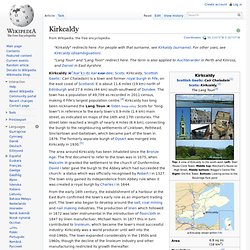
It is about 11.6 miles (19 km) north of Edinburgh and 27.6 miles (44 km) south-southwest of Dundee. The town has a population of 49,709 as recorded in 2011 census, making it Fife's largest population centre.[4] Kirkcaldy has long been nicknamed the Lang Toun ( listen ; Scots for "long town") in reference to the early town's 0.9-mile (1.4 km) main street, as indicated on maps of the 16th and 17th centuries. Kirkcaldy Feature Page on Undiscovered Scotland. Kirkcaldy lies around a broad curve of the north shore of the Firth of Forth.
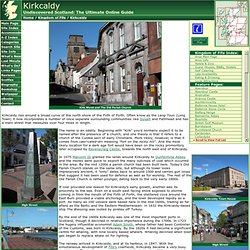
Often know as the Lang Toun (Long Town) it now incorporates a number of once separate surrounding communities like Dysart and Pathhead and has a main street that measures over four miles in length. Browser Population. Kirkcaldy. Home of the longest street fair in Europe, Kirkcaldy is a town on the Fife coast.

Nowadays the top attraction is Kirkcaldy's Links Market, Europe's longest street fair, with over 200 fairground rides and attractions, held each Easter on the town esplanade. The Kirkcaldy Museum and Art Gallery is set to reopen in 2013 after undergoing a £2.5 million redevelopment and the Adam Smith Theatre, just across the road, provides a wide programme of entertainment with everything from pantomime and music to theatre and comedy. Kirkcaldy's Home on the Web. Home. Fife Council Development Services - c64_KirkcaldyTownCentreFS.pdf. Kirkcaldy 4 All. Links Market. The Links Market in Kirkcaldy, Fife is Europe's longest street fair[1] and the oldest in Scotland.
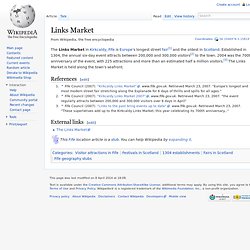
Established in 1304, the annual six-day event attracts between 200,000 and 300,000 visitors[2] to the town. 2004 was the 700th anniversary of the event, with 225 attractions and more than an estimated half a million visitors.[3] The Links Market is held along the town's seafront. References[edit] Jump up ^ Fife Council (2007). "Kirkcaldy Links Market". www.fife.gov.uk. Retrieved March 23, 2007. External links[edit] The Links Market, Kirkcaldy, Fife, Scotland. Kirkcaldy's Home on the Web. The Links Market is one of the world's oldest and longest street fairs, containing a variety of rides and stalls.
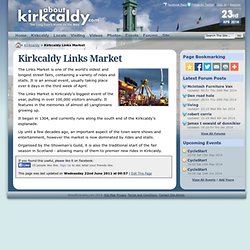
It is an annual event, usually taking place over 6 days in the third week of April. The Links Market is Kirkcaldy's biggest event of the year, pulling in over 100,000 visitors annually. It features in the memories of almost all Langtonians growing up. It began in 1304, and currently runs along the south end of the Kirkcaldy's esplanade. Up until a few decades ago, an important aspect of the town were shows and entertainment, however the market is now dominated by rides and stalls.
Kirkcaldy Links Market. View topic - Kirkcaldy Links Market 2013. Kirkcaldy set for all the fun of the fair - Fife. All the fun of the fair will return to Kirkcaldy this week as the Links Market comes to town.
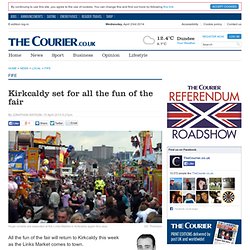
Thousands of revellers will descend on the waterfront for six days of thrills and excitement in one of the highlights of the town’s entertainment calendar. The funfair, which can trace its origins to the 14th century, will open to the public on Wednesday afternoon. Alex James Colquhoun, of the Showmen’s Guild, said this year’s event will be as spectacular as ever. “We’ve got two new rides this year — Atmosphere and Voodoo Dancer — as well as all the other favourites,” he said. “The Links Market is huge for showmen as it traditionally marks the start of our season in Scotland. “We’re all aware of its history. As many as 200,000 revellers will flock to the esplanade this week to enjoy the white-knuckle rides, stalls and amusements. Research and Articles - History of Fairs - Historic Fairs - Kirkcaldy Links Market. Kirkcaldy remains the premier funfair in Scotland, evolving from a charter granted by Edward I in 1304.

Return of the Lang Toun Lad and Lass. THE search is on to find the new Lang Toun Lad and Lass.
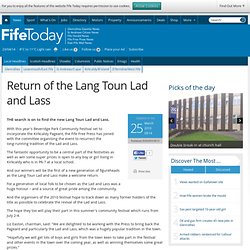
With this year's Beveridge Park Community Festival set to incorporate the Kirkcaldy Pageant, the Fife Free Press has joined with the committee organising the event to resurrect the long-running tradition of the Lad and Lass. The fantastic opportunity to be a central part of the festivities as well as win some super prizes is open to any boy or girl living in Kirkcaldy who is in P6-7 at a local school. And our winners will be the first of a new generation of figureheads as the Lang Toun Lad and Lass make a welcome return.
Kirkcaldy Bands Index Page. Adam Smith. 18th-century Scottish moral philosopher and political economist Adam Smith FRSA (16 June [O.S. 5 June] 1723[4] – 17 July 1790) was a Scottish economist, philosopher and author as well as a moral philosopher, a pioneer of political economy and a key figure during the Scottish Enlightenment,[5] also known as ''The Father of Economics''[6] or ''The Father of Capitalism''.[7] Smith wrote two classic works, The Theory of Moral Sentiments (1759) and An Inquiry into the Nature and Causes of the Wealth of Nations (1776).
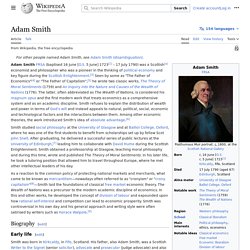
The latter, often abbreviated as The Wealth of Nations, is considered his magnum opus and the first modern work of economics. In his work, Adam Smith introduced his theory of absolute advantage.[8] Smith studied social philosophy at the University of Glasgow and at Balliol College, Oxford, where he was one of the first students to benefit from scholarships set up by fellow Scot John Snell. Adam Smith. Robert Adam. Robert Adam was a leader of the first phase of the classical revival in England and Scotland from around 1760 until his death.[2] He influenced the development of Western architecture, both in Europe and in North America.

Adam designed interiors and fittings as well as houses.[3] Biography[edit] Early life[edit] Royal High School (1578-1777) on site of Blackfriars Monastery, Edinburgh. On his recovery from illness in 1746, he joined his elder brother John as apprentice to his father. Robert Adam. Gordon Brown.
David Steel. Early life[edit] Member of Parliament[edit] As an MP he was responsible for introducing, as a Private Member's Bill, the Abortion Act 1967 (see Abortion in the United Kingdom). He also became the Liberal Party's spokesman on employment, and in 1970 its Chief Whip. Leader of Liberal Party[edit] In 1976, after the downfall of Jeremy Thorpe and a short period in which Jo Grimond acted as caretaker leader, he won the Liberal leadership by a wide margin over John Pardoe.
Steel has been criticised both then and since for not driving a harder bargain; the opposing case is that the continuing scandal surrounding Thorpe left the party in a very weak state to face an early general election and Steel was wise to buy himself some time from Callaghan. SDP-Liberal Alliance[edit] In 1981, a group of Labour moderates left their party to form the Social Democratic Party. Steel had genuine hopes at this stage that the Alliance would win the next general election and form a coalition government.
Sandford Fleming. Sir Sandford Fleming, KCMG (January 7, 1827 – July 22, 1915) was a Scottish-born Canadian engineer and inventor. He proposed worldwide standard time zones,[1] designed Canada's first postage stamp, left a huge body of surveying and map making, engineered much of the Intercolonial Railway and the Canadian Pacific Railway, and was a founding member of the Royal Society of Canada and founder of the Royal Canadian Institute, a science organization in Toronto. Early life[edit] In 1827, Fleming was born in Kirkcaldy, Fife, Scotland to Andrew and Elizabeth Fleming. At the age of 14 he was apprenticed as a surveyor and in 1845, at the age of 18, he emigrated with his older brother David to Ontario (then the western half of the Province of Canada, at that time called Canada West). Their route took them through many cities of the Canadian colonies, Quebec City, Montreal, and Kingston, Ontario, before settling in Peterborough, Ontario with their cousins two years later in 1847.